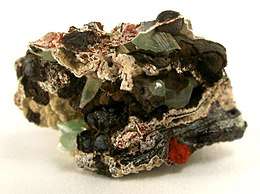Fraipontite
| Fraipontite | |
|---|---|
|
Pockets of minute pearly white fraipontite crystals with green smithsonite from Laurium, Greece (size: 1.4 x 1.0 x 0.9 cm) | |
| General | |
| Category | Phyllosilicate |
| Formula (repeating unit) | (Zn,Al)3(Si,Al)2O5(OH)4 |
| Strunz classification | 9.ED.15 |
| Crystal system | Monoclinic |
| Crystal class |
Domatic (m) (same H-M symbol) |
| Space group | Cm |
| Unit cell |
a = 5.34, b = 9.21 c = 14.12 [Å]; β = 93.2°; Z = 2 |
| Identification | |
| Color | Blueish, yellow white light green |
| Crystal habit | Fibrous to porcelaneous massive |
| Mohs scale hardness | 3.5 – 4 |
| Luster | Silky |
| Streak | White to pale green |
| Diaphaneity | Opaque to translucent |
| Specific gravity | 3.08 – 3.10 |
| Optical properties | Biaxial (-) |
| Refractive index | nα = 1.620 nβ = 1.624 nγ = 1.624 |
| Birefringence | δ = 0.004 |
| 2V angle | Measured: 15° to 20° |
| References | [1][2][3] |
Fraipontite is a zinc aluminium silicate mineral with a formula of (Zn,Al)3(Si,Al)2O5(OH)4.[1][2]
It is a member of the kaolinite-serpentine mineral group and occurs as an oxidation product of zinc deposits. It occurs with smithsonite, gebhardite, willemite, cerussite and sauconite.[1]
It was first described in 1927 for an occurrence in Vieille Montagne, Verviers, Liège Province, Belgium.[2] It was named for Julien Jean Joseph de Fraipont (1857–1910), and Charles de Fraipont, geologists of Liege, Belgium.[3] In addition to the type locality in Belgium, it has been reported from Tsumeb, Namibia; Laurium, Greece; Swaledale, North Yorkshire, England; the Silver Bill mine, Cochise County, Arizona, the Blanchard Mine, Socorro County, New Mexico and the Mohawk mine, San Bernardino County, California in the US; and from the Ojuela mine, Mapimi, Durango, Mexico.[1]
A synonym for fraipontite is zinalsite which was reported in 1956 for an occurrence in Kazakhstan.[4][5]
References
External links
![]() Media related to Fraipontite at Wikimedia Commons
Media related to Fraipontite at Wikimedia Commons
